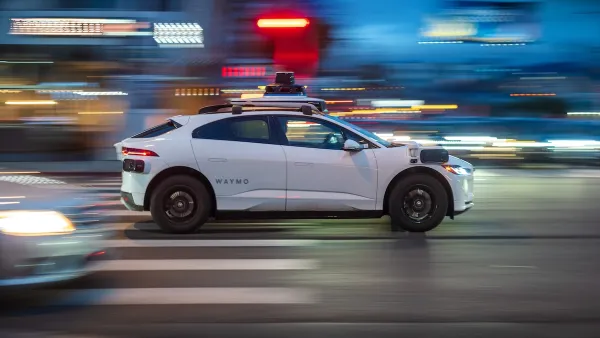While we're still far from a Jetsons-style reality, understated autonomous features could be the key to safer transportation.

With billions of dollars invested in autonomous vehicles and federal policy undergoing revision to accommodate them, Allison Arieff, writing in City Monitor, takes stock of the industry and its actual achievements and potential.
Arieff starts with the basic questions about the role of autonomous vehicles in our lives. "What problem are they going to solve? Is the goal to end car ownership? Kill public transit? Rescue public transit? Normalise super-commutes? Eliminate the need for parking lots?" With 2020 making every industry reevaluate its priorities, AV developers and investors are shifting the discussion to focus on the realistic ways that autonomous vehicles can craft their niche, looking at avenues such as "buses, transit and last-mile goods delivery."
Whereas autonomous cars once promised safety as a top feature, the advances being implemented in human-driven cars have the potential to make that advantage obsolete. "By 2022, just about every new vehicle sold in the world’s wealthy nations will have at least automatic emergency braking, which is expected to reduce injury-related crashes by 56% and reduce rear-end crashes by half." And, Arieff argues, "too much focus on tech that may or may not be as deployable or as transformative runs the risk of crowding out more important transportation conversations about low-hanging fruit like reduced speed limits, road diets and congestion pricing."
Autonomous vehicles seek to separate the driver from the driving, but they're not out to remove them from the car altogether. "Startups are focusing on what you can be doing during your trip, whether in an AV or on mass transit," but not on reducing the number of cars on the road. "Instead of exploring more effective solutions that could carry more people from one destination to the next, the driverless vehicle, by definition, keeps the car as the number one choice for getting from A to B."
Recent changes, however, point to a renewed focus on integration with transit, last-mile solutions, and goods movement. "The integration of AV technology into public transport networks and delivery systems presents new opportunities to develop multimodal systems for equitable, accessible and sustainable urban mobility." As Arieff writes, the future of autonomous vehicles may not be flying taxis, but safer and more reliable buses—and that's not a bad thing.
FULL STORY: The underwhelming reality of driverless cars

Planetizen Federal Action Tracker
A weekly monitor of how Trump’s orders and actions are impacting planners and planning in America.

Chicago’s Ghost Rails
Just beneath the surface of the modern city lie the remnants of its expansive early 20th-century streetcar system.

Amtrak Cutting Jobs, Funding to High-Speed Rail
The agency plans to cut 10 percent of its workforce and has confirmed it will not fund new high-speed rail projects.

Ohio Forces Data Centers to Prepay for Power
Utilities are calling on states to hold data center operators responsible for new energy demands to prevent leaving consumers on the hook for their bills.

MARTA CEO Steps Down Amid Citizenship Concerns
MARTA’s board announced Thursday that its chief, who is from Canada, is resigning due to questions about his immigration status.

Silicon Valley ‘Bike Superhighway’ Awarded $14M State Grant
A Caltrans grant brings the 10-mile Central Bikeway project connecting Santa Clara and East San Jose closer to fruition.
Urban Design for Planners 1: Software Tools
This six-course series explores essential urban design concepts using open source software and equips planners with the tools they need to participate fully in the urban design process.
Planning for Universal Design
Learn the tools for implementing Universal Design in planning regulations.
City of Fort Worth
Mpact (founded as Rail~Volution)
City of Camden Redevelopment Agency
City of Astoria
City of Portland
City of Laramie





























